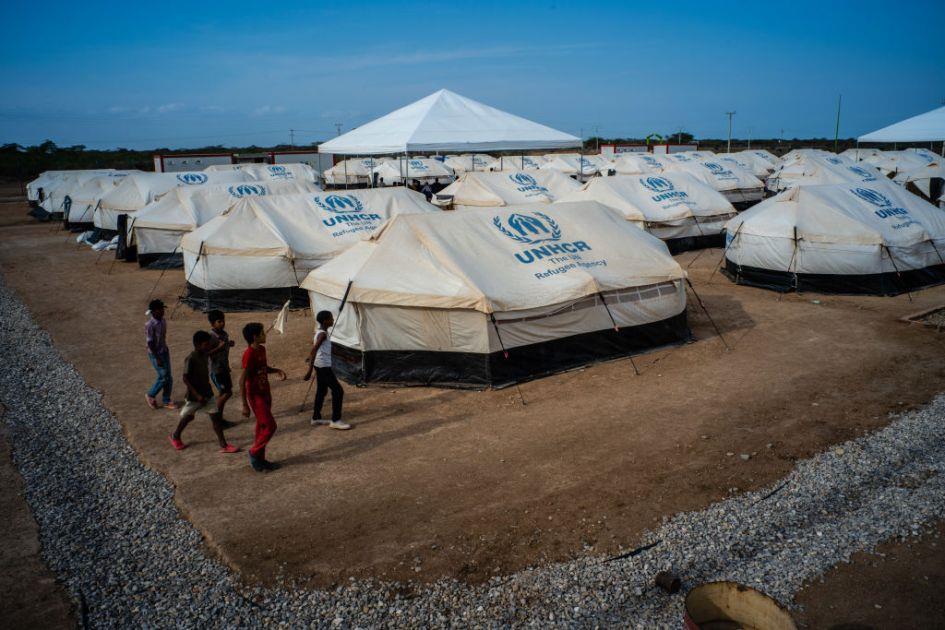
How Blockchain Is Making Humanitarian Cash Transfers Faster And Safer
-
Deutsch
de
Hilfsgelder verteilen hat Tücken – Blockchain verspricht Lösungen
Original
Read more: Hilfsgelder verteilen hat Tücken – Blockchain verspricht Lösunge
Português
pt
Refugiados sem banco, mas com carteira digital
Read more: Refugiados sem banco, mas com carteira digita
In mid-2024 there were more than 122 million displaced peopleExternal link worldwide, according to the United Nations. Global crises are creating ever more complex challenges, which require fast and flexible responses over long distances. This is true for all aid – including, and perhaps especially, money transfers.
“Transactions across national borders are often slow and costly. Also, many crisis regions just don't have the necessary infrastructure,” says Stefan Bumbacher, a programme manager for cash and voucher assistance at the Swiss Agency for Development and Cooperation (SDC).
Each year, billions of dollars are disbursed in humanitarian and development aid, but inefficient processes can slow down the entire system. And the biggest question is always: is the money actually getting to the people it is supposed to reach.
More More Our weekly newsletter on foreign affairsSwitzerland in a fast-moving world. Join us to follow the latest Swiss foreign policy developments. We offer the perfect immersive package.
Read more: Our weekly newsletter on foreign affair Halfway around the world without a bank accountBlockchain technology offers a solution for this, as it enables transactions that are transparent, secure and decentrally managed. All payments are stored in an unchangeable register that can neither be manipulated nor stopped.
A pilot project run by UNHCR in Ukraine shows how blockchain technology can be used in practice. The agency worked with the Stellar Development Foundation, a specialist in this technology, to implement an innovative blockchain payment solution for the distribution of digital cash to internally displaced people and refugees.
The pilot projectExternal link , which was rolled out in December 2022, ensured that cash aid was delivered directly into the hands of those being assisted – wherever they were and in real time.
More How Switzerland is managing foreign aid at a time of global upheavalSwitzerland, like other rich nations, is grappling with a shrinking foreign aid budget, as the war in Ukraine forces a reset in its priorities.
Read more: How Switzerland is managing foreign aid at a time of global upheavaFor the people concerned the process is simple: after registering with UNHCR, they receive a text message instructing them to download a wallet app – a digital wallet for receiving and sending money – on their smartphone. A few minutes after verification, they receive the UNHCR aid payments directly on the app.
All they have to do then is go to the nearest MoneyGram branch and exchange the credit balance for the currency of their choice; no bank account is needed to access cash. Ukraine alone has over 4,500 MoneyGram branches where such withdrawals can be made.
Fast, agile and secureOne year after the project began, the UN had, in this way, paid out over $1.1 million (CHF1 million) to 1,500 displaced people in Ukraine.
Using blockchain makes sense not just because of its speed but also its flexibility, explains Malik El Bay from the Zurich think tank Dezentrum. A displaced person can keep the money safely in their digital wallet or withdraw it in any currency – wherever they are, and even if there is no functioning banking system.
If they flee to Poland, for instance, they can simply take the money across the border on their smartphone and withdraw it at a branch in Krakow.
People walk past the scene of a Russian bomb attack on a residential building in Kharkiv, northeastern Ukraine, on May 5, 2024 . KEYSTONE
But surely a solution of this kind exposes vulnerable people to the strong price volatility of cryptocurrency? To avoid this, the project makes use of so-called stablecoins – cryptocurrencies whose value is pegged to a conventional currency, such as the US dollar.
Thus, in Ukraine the Circle Internet Financial's USD CoinExternal link (USDC) is used. This is a stablecoin that is fully backed by cash, short-term government bonds and similar liquid assets.
A new centre of excellence in GenevaFollowing the successful launch of the pilot project in Ukraine, UNHCR, various UN partners and the Swiss government launched the Digital Hub of Treasury Solutions (DHoTS) in 2022. The hub's mission is to promote financial inclusion in order to improve the lives of people in need around the world.
An important step in this direction is the creation of a UN Centre of Excellence in Geneva, which the SDC is helping fund to the tune of CHF1 millionExternal link until early 2026. The aim of the new centre is to facilitate access to global financial ecosystems and markets for the UN system and its partners.
“In addition to the use of new technologies, the DHoTS seeks to promote multilateral cooperation in order to make development cooperation more efficient and secure,” explains Alexander Widmer, who is in charge of the project at the SDC.

Legal Disclaimer:
MENAFN provides the information “as is” without warranty of any kind. We do not accept any responsibility or liability for the accuracy, content, images, videos, licenses, completeness, legality, or reliability of the information contained in this article. If you have any complaints or copyright issues related to this article, kindly contact the provider above.






















Comments
No comment